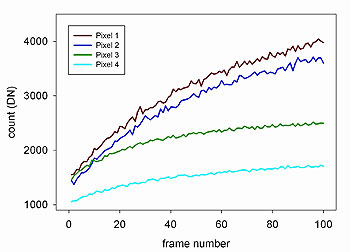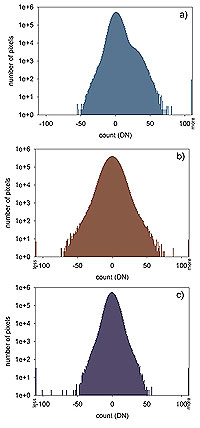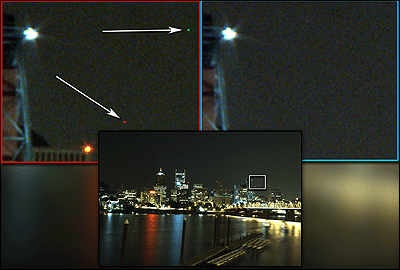By Ralf Widenhorn, professor; Justin C. Dunlap, graduate student; and Erik Bodegom, professor and chair, Department of Physics, Portland State University
Since the advent of digital cameras, astronomers have known and struggled with dark current in images with long exposure times. In the past, the camera of choice for amateur astronomers has often been an expensive cooled scientific camera. With the emergence of high-quality DSLR cameras, it is easier now to equip a telescope with a camera and point it to the night sky. Users of DSLR cameras can choose exposure times of up to 30 seconds, or even longer with the bulb setting or using external computer control. Even compact cameras now allow extended exposure times to the point where dark current becomes an issue. The routine cooling of consumer cameras is unrealistic, but dark current is doubled when the silicon comprising the imagers within the digital cameras is increased in temperature by about 6 to 8°C. Thus, hot pixels (or pixels with unusually great amounts of dark current) may inadvertently transform into false stars in long exposures of the night sky on a warm summer night. There are various methods for dealing with dark current, but they all have problems. But an alternative method has been shown to be successful for scientific cameras is also a viable alternative method for consumer cameras.
Correcting for dark current: standard options

Dark count for four pixels in 100 consecutive frames using the Canon EOS-20D.
Manufacturers of consumer cameras are well aware of the issue of dark noise at high ISO settings, long exposure times or high temperatures. Most cameras therefore have an automatic noise reduction mode. For example, after exposures longer than 1 second, Canon cameras are nonresponsive for slightly longer than the exposure time. It is probable that this time is dedicated to the taking of a frame with no exposure to light, commonly called a dark frame. This technique is known to astronomers as single frame dark correction, as the dark frame is subtracted from the initial image in hopes of correcting for the dark noise and leaving an image containing only a light signal. For a 30-second image, this results in an additional 30-second delay before a new picture can be taken. This is valuable time in a photo session where conditions could be changing rapidly. A user can obtain the same result by subtracting a dark frame taken separately right after the exposure, but this still requires the taking of a dark frame with the same long exposure time as the image.
The success of single frame correction is always limited by dark current shot noise, noise that decreases relatively with the length of an observation. Astronomers therefore often take multiple dark frames and average them to generate a so-called master dark frame. While decreasing the shot noise, this method takes significantly longer than the single frame method. Complicating any method of correction is that not all manufacturers allow you to access the raw data generated by the imager. Nikon DSLRs investigated in this study would apply a median filter to the data, leaving the user with a processed image. While effectively removing hot pixels, applying a median filter generally degrades image quality and has the side effect of possibly removing a star in a shot of the night sky.

Dark frame correction with a) master frame, b) single frame, c) computed frame.
While master frames are useful for scientific cameras, we found that this may not hold for consumer cameras. The parameters controlled by the photographer (exposure time and ISO) and the external conditions (temperature) were not sufficient to accurately predict the dark current. This was true for all the consumer cameras we investigated – Canon EOS-20Da, Canon PowerShot SD1000, Canon EOS-20D, Nikon D70, Nikon D700, Canon S2IS, Canon PowerShot A570 IS, Canon EOS Rebel XS) – irrespective of whether they were DSLRs or compact cameras, or if they had a CCD or a CMOS sensor.
Mimicking the conditions of a long photography session, Figure 1 shows the dark current of four hot pixels for the Canon EOS-20D for 100 consecutive 30-second exposures at constant gain (ISO=800) and outside temperature (24 °C). Even though all external parameters were kept constant, the dark current of all four pixels increases significantly from the first to the last frame; this is likely due to a temperature increase inside the sensor itself. Figure 2a shows the consequence this has for a master dark frame correction when 10 frames were used to generate a master frame at the beginning of the run and then subtracted from the final dark frame in the series. The single frame correction shown in Figure 2b does not show the bulge, but the shot noise causes a widening of the distribution.
Hot pixels: an alternative method
We found that a better method than those presented above is to use hot pixels on the chip itself as dark current indicators. The dark current of a collection of well-chosen hot pixels can serve as an accurate measure of the conditions of the chip for each image. To be accurate dark current indicators, the camera has to be calibrated using dark frames taken at different exposure times, temperatures and ISO settings. Figure 2c shows the results after correcting the same dark frame as in the previous corrections, but was corrected by using dark current indicators (we have a patent pending for the calibration and correction using indicator pixels).

Hot pixels in a night exposure of Portland, Oregon.
The presence of light when taking an actual image will throw off the dark current prediction for some indicator pixels; however, only indicator pixels receiving significantly different signals than their neighbors will indicate the wrong dark current for the image. Using a sufficiently large number of indicator pixels will insure an accurate agreement on the dark current for an image. The indicated dark current can then predict the dark current for every pixel, even for those pixels affected by the light. Figure 3 shows the result of dark current correction with this method for a 25-second shot of Portland, Ore., at night using the Canon EOS-20D. While the print of the image is too small and hides most of the noise, a closer look at a small section reveals two “stars,” which are actually hot pixels. Using the method described above, the dark current of these hot pixels was correctly indentified and removed.
Conclusion
While single frame dark noise correction for consumer cameras, either using the automatic noise correction or a manually taken frame, does decrease dark current noise, the correction has significant shot noise and requires a long wait between images. The use of a master frame is even more problematic as it requires additional time and suffers from changing dark current. While requiring a calibration of the imager, the use of actual pixels on the chip can mitigate these issues. It can even be used retroactively for the correction of images taken prior to the calibration. Best of all, more time can be spent taking images of real stars rather than removing the false ones.
For more information, contact: Ralf Widenhorn, [email protected]